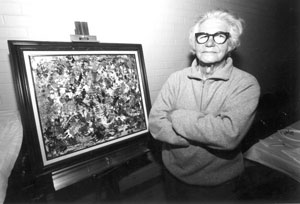Bernard Goodman, a former seaman and longtime social justice activist who achieved a reputation as an artist after he started painting at the age of 80, died on May 26 at Beth Israel Hospice of a stroke at the age of 93.
His life will be celebrated at a memorial service at 4 p.m. Sat. Aug. 9 at the National Arts Club, 15 Gramercy Park S.
His work has been shown at N.A.C, the Museum of American Folk Art, Hudson Guild, the Outsider Art Show in January of last year and most recently last March in the Clocktower studios on Broadway and Leonard St.
Born in Brooklyn on Feb. 19, 1910, and raised in an orphanage with his older sister after their parents died when he was 2 years old, Bernard Goodman started working at odd jobs when he left the orphanage at the age of 16. He became a merchant seaman in his early 20s and began a life of social action in the beginning of the Depression.
“I met him when I was 17 1/2 — I was a member of the Young Socialists League,” recalled Pauline, his wife of 63 years. “He was speaking about the rights of poor people. He was a very loving, gentle man but very powerful when it came to human rights,” she said.
At the beginning of World War II, Bernie Goodman began sailing out of San Francisco as a member of the Sailors Union of the Pacific. When the war ended, he and his wife returned to New York where he began organizing for the Seafarers’ International Union, an affiliate of the S.U.P. He was active in trying to integrate black and white seamen on merchant ships, but although he was not a communist, he was hounded out of the union during the Red purges of the mid-1950s.
He then became a house painter and continued to work on social justice campaigns. He and his wife became involved in tenant issues at the end of the 1960s, and in the early ’70s he mounted a campaign as the candidate of the newly organized Tenants’ Party for the Congressional seat held by Edward I. Koch.
“Bernie debated Koch at the school on W. 11th St. [P.S. 41] and the audience got so angry that the police were summoned and cleared the place,” recalled Pauline. The Tenants’ Party however, was thrown off the ballot after a petition challenge.
Goodman then did social work on behalf of tenants for the Legal Aid Society and worked as a volunteer at the Chelsea Action Center, a housing action group.
“He wasn’t doing much after he retired when he was 80, so I bought him an acrylic paint set,” Pauline recalled. “He told me he started painting, making brush strokes on a canvas and then decided, ‘This isn’t for me.’ He walked away from the canvas and when he turned around it looked like things were moving on it, so he went back to work on it some more.”
His work attracted the notice of Lee Kogan, director of the Museum of American Folk Art, and the British art critic Roger Cardinal.
In addition to his wife, their daughter, Jaimey Steele, and a grandson, Matthew Steele, also survive. His ashes will be scattered at sea.




































